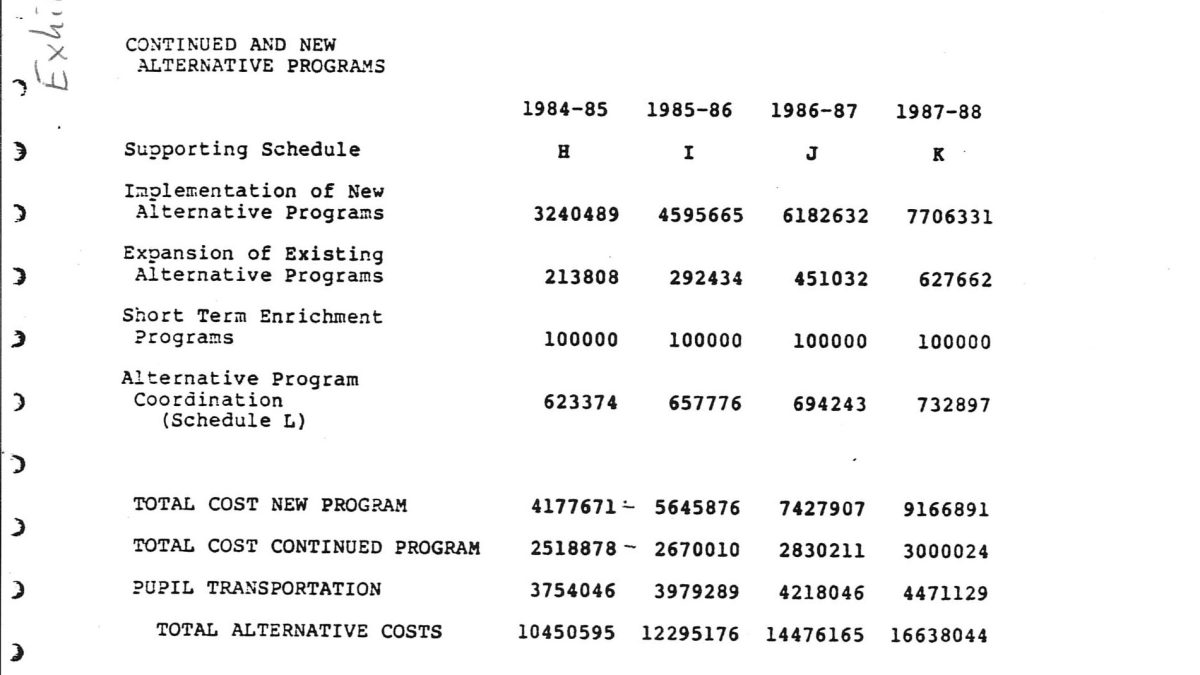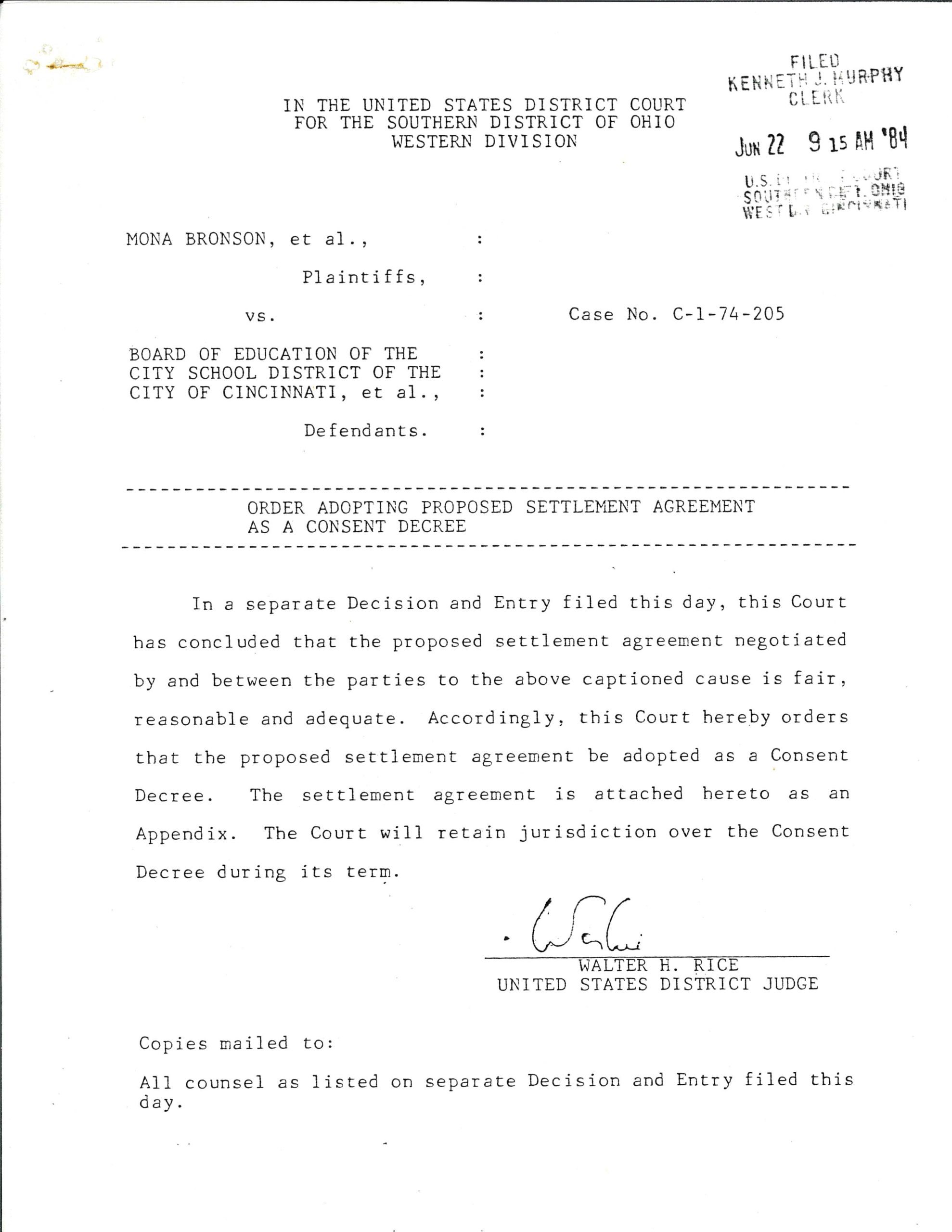Last November, the University of Cincinnati Libraries announced the award of an Archives Grant from the National Historical Publications and Records Commission to the Libraries’ Archives and Rare Books Library (ARB). This grant supports the archival processing of records related to the lawsuit Bronson v. Board of Education of the City School District of the City of Cincinnati maintained by the local branch of the National Association for the Advancement of Colored People (NAACP) and donated to the University of Cincinnati in the 1980s.
As ARB wraps up the project to process the records of the Cincinnati Branch of the NAACP regarding the 1974 lawsuit Bronson v. Board of Education of the City School District of the City of Cincinnati, we look at the 1984 settlement agreement that brought to an end the decade-long legal struggle to end racial isolation in Cincinnati’s public schools.

On April 6, 1984, the ten-year lawsuit ended when a final settlement was approved by all parties and fairness hearings were conducted. Although the case did not go to trial, it is clear through the thousands of exhibits, dozens of deposed individuals and numerous lawyers that the case had a lasting impact on the city of Cincinnati. The settlement called for Cincinnati Public Schools to lessen racial isolation in the school system by 1991. The four major sections of the settlement stated:
- The Cincinnati Board of Education had seven years to reduce the current Taeuber Index of Dissimilarity score by 17 points. This index measured racial composition within an individual school compared to the school district.
The index spans from 0 to 100 where 100 represents full racial isolation and 0 equals full integration of the corresponding district. At the time of the settlement, Cincinnati Public Schools had a Taeuber Index of Dissimilarity score of 53 points. Within the next seven years the schools were to reach a score of 36 points in order to successfully fulfill the terms of the agreement.
2. The Board could decide how it would reduce racial isolation. However, it had to claim responsibility for this action in order to achieve the target Taeuber Index score.
A significant component in reducing racial isolation was expanding and creating new alternative schools and programs. This would in theory transfer more students from schools that were composed of a majority of one race regardless of segregated neighborhoods. These new programs would be funded through the State Department of Education, which also agreed to provide assistance.
Secondary goals were detailed in the settlement which were to be reached alongside the reduction in racial isolation. This included aiding schools with low test scores and low grades, open enrollment, transportation support, racially balancing staff, and implementing unbiased tests and policies.
3. The State would provide financial assistance for efforts in reducing racial isolation with some restrictions.
It was agreed that the State Board of Education would provide $35 million over the next seven years. This amount was in addition to regular yearly assistance. Newspaper articles in the NAACP-Bronson collection detail the community’s frustration with the allocation of funds, primarily regarding how much money went towards alternative programs compared to how much was spent on supporting low-achieving schools.

4. A committee would meet yearly to review the district’s progress.
In efforts to manage the implementation of the settlement, a 14-person community-wide task force and facilitator would meet to ensure the settlement was properly followed and supported. The facilitator would be chosen by the court and agreed upon by the plaintiffs and defendants. The task force members would be appointed by the plaintiffs and defendants evenly.
The Bronson v. Board records contain material related to the settlement agreement in the attorney files and pleadings series.

The seven-year deadline approaches
By 1991 many changes took place within Cincinnati Public Schools which saw the achievement of some, but not all, the settlement requirements.
The Taeuber Index of Dissimilarity target score of 36 was reached. This did not mean the schools were fully desegregated, just that the district was able to improve balancing the schools over the preceding seven years and schools had not reverted back to their original scores.
Efforts to strengthen test results of low-achieving students proved to be difficult. Cincinnati Public Schools created a program titled “Effective Schools” to assist low-achieving schools, which was at first promising but quickly proved to be unsuccessful when test scores and grades fell back to earlier trends and stayed down.
The settlement did not outline specific goals for creating unbiased disciplinary policies, just that they had to make improvements. This would allow the district freedom to choose how they would do so as long as they made annual reviews of the policies. In 1989, the district did not administer the yearly review, which as a result was a violation of the consent decree and settlement
The settlement stressed maintaining staff racial balance in each of the schools. This meant that “staff in each of its schools has a racial composition which is within 5% of the racial composition of the staff in the district as a whole” (Rice 26). This policy was put in place to ensure there was no discrimination when selecting staff members for each school. By 1991, not all of Cincinnati’s schools had a staff racial composition within 5% of the district. By not reaching that target, the schools again broke the consent decree.
As a result of the multiple violations, the settlement matters were now going to be administered by the court directly with monthly reviews. This meant that the court could force specific actions to reach those goals. It was not until 1992 that the court found that the school board had reached all the goals laid out in the original settlement from 1984, and no further action was needed.
Works Cited
Rice, Walter H. (1991). “Mona Bronson, et al., Plaintiffs, vs. Board of Education of the City School District of the City of Cincinnati, et al., Defendants” Case No. C-1-74-205. ERIC, 1–38. ERIC – ED339758 – Mona Bronson, et al., Plaintiffs, vs. Board of Education of the City School District of the City of Cincinnati, et al., Defendants. Case No. C-1-74-205., 1991-Jun-25
This project has been made possible in part by grant RH-104772-24 from the National Historical Publications and Records Commission (NHPRC). Any views, findings, conclusions, or recommendations expressed in this blog post do not necessarily represent those of the NHPRC.

